Data Light Turns Off On Char-broil Sikmple Smoker During Update?
I know you desire to buy an kickoff. It looks and so macho. It says "I'm serious about charcoal-broil". And Domicile Depot has ane for only $200! Slow down, Dale Earnhardt. Yes, offsets await cool, but the cheap ones have turned more people off barbecue than any other smoker. Later 1 flavour of frustration, owners dump them and often never return to smoking. They impale the curious.

Let'due south dissever the world of offsets into two categories: EOS and COS. In that location is a large deviation in quality betwixt the Expensive Offset Smokers (EOS) in the $800 and upwards range like Horizon or Lang, and the Cheapo First Smokers (COS) in the $400 and under range. The most popular COS ordinarily found in hardware stores are Brinkmann Pitmaster, Brinkmann Smoke'N Pit Professional, Char-Broil Silver Smoker, Char-Bake American Gourmet, and peculiarly the Char-Griller Smokin Pro. Stay away from them, delight.
COS have serious shortcomings that can mar meals and marriages. At the core of the problem is the uncomplicated fact of physics: Heat and smoke want to go up, not sideways. So rut and smoke leave the firebox on one side and endeavour to go up making the side of the cooking sleeping room adjacent to the firebox much hotter than the side next to the chimney. So if you put on half-dozen slabs of ribs, some will be washed way sooner than the others. Yes, you can move them around, but that's a pain, and they all the same come out uneven.
COS as well have poor fire management control because the fireboxes leak so badly then you cannot control oxygen and that is what controls temperature and smoke quality. The food sleeping room doors also leak so you tin can't control the draw of air with the chimney damper. That hot air seeping out the doors as well carries with information technology moisture from your meat.
COS are designed and build poorly. Paint flakes off and they are prone to rust.
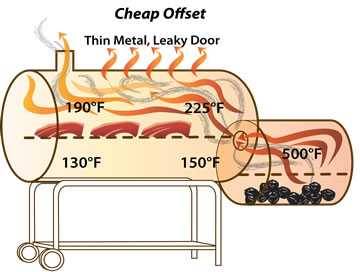
EOS are made from thick metal that absorbs and distributes rut more evenly end to end, their doors and dampers are tight so y'all can actually command temp. Some even have a duct system that forces the hot air to travel the length of the cooking chamber under a thick metallic plate that warms the space from below, and the chimney is located on the same side as the firebox and so that information technology pulls the warm air across the top of the food.

Please resist the temptation to purchase a COS. If you have to look manlike, get a drum smoker. Information technology can cook circles effectually the cheap offsets.

Click here for an article with our impressions of many of the different beginning smokers on the market, in all price ranges. Simply if yous desire something that looks macho and works well, go a pulsate smoker. At only $350 (shipping included), the Pit Butt Cooker will cook circles around any COS. If you prefer, in that location is even an piece of cake to get together kit that you tin can build yourself, or they'll build it for yous.
How to tame your offset
If y'all have an offset, hither are some important techniques and modifications to make, inexpensive or otherwise:
1) Cook with charcoal, not wood. Woods fires are too hard to manage in a COS, and they can hands spoil the meat with as well much fume, creosote, soot, or ash. A common question: "How much charcoal should I start with?" There are as well many variables for a pat answer. It depends on how hot a day it is, how windy, how tight your cooker is, how heavy the metal is, how much cold meat is inside, and where the meat is in the cooking chamber (it can vary as much as l°F from side to side). This is the craft of BBQ and it volition take a few cooks for you to get the experience of your auto. Start with about 1 chimney of lit charcoal and a good thermometer and a cooking log.
two) Preheat the cooker. Start your coals and look until the cooking chamber is up to temp before putting the meat in. This will assistance forestall bitter creosote from forming.
3) Add together fully lit coals. Employ a chimney to get-go the coals earlier you start cooking. Then, when the temperature begins to decline because the dress-down are fading, add only fully lit dress-down from the chimney.
4) Use good thermometers on both ends. Beware of the fact that the oestrus about the firebox can be 50°F higher than by the flue. Drill holes in the door on each end and insert a adept digital thermometer probe in each to monitor the temperature on both sides of the cooking chamber. In that location are several models that have more than than one probe. If you must, mount a couple of Tel-Tru BQ300 Bi-metal Charcoal-broil Thermometers with 4″ stems as indicators, but apply a digital adjacent to the meat for real accuracy.
v) Don't soak your wood chips or chunks. The wood absorbs only about 5% of its weight in h2o and the water but cools the coals when y'all add it. This tin cause yo-yoing temperatures.
six) Keep the lid closed. Opening the doors, either on the firebox or the cooking chamber, upsets the fragile remainder of oxygen on the coals.
7) Rotate the meat. If you lot accept meat on the left and meat on the right, they will need to be switched halfway through the cooking.
8) Learn one vent at a fourth dimension. Most COS have an intake baffle and a chimney bamboozle. Begin by controlling the temperature with the intake baffle simply and go out the chimney wide open. The intake baffle controls oxygen menstruum to the coals and has the most touch on on cooking temperature. The chimney controls smoke in the cooking chamber (somewhat), and the temperature differential from one side to the other (somewhat). Beginning with the intake wide open until the chamber is up to temp, and so shut it half way or more until the temp stabilizes in the 225-250°F range on the hot side. Never close the intake all the style or the fire can starve and produce creosote. Don't touch the chimney until the cooking chamber is stable for 30 minutes or more.
nine) Become easy on the smoke. It is easy to ruin meat with too much fume. Use chips, chunks, or pellets. Add about 4 ounces at a time in 3-4 doses every 30 minutes, starting as soon as the cooking sleeping accommodation gets over 200°F.
10) Beware of the weather condition. The ambience temperature will event the cooking temperature, and rain (or snow) and wind tin significantly affect cooking temperature.
11) Pull up a chair. Bring a book, a beer, and some tunes, and stay near your cooker.
12) Protect your investment. Your COS will rust. When it is non in use, apply a cover or park it in the garage. Put your auto on the street. It won't rust. Sand out rust and repaint with rut-resistant paint. If y'all use information technology on the interior, let it dry thoroughly before cooking. The fumes are poisonous.
thirteen) Use a water pan. Put a grate above the coals and put a water pan on the grate. This will add humidity to the smoke and help the season and moistness. Don't carp putting water pans under the meat, and don't waste product money on apple tree juice in the pan.
fourteen) Calibrate it with dry runs. The outset thing to practise subsequently you lot gather your new grill or smoker is to season it and calibrate it by doing a few dry out runs without food. This will burn off whatever manufacturer's grease, and give you lot a sense for how to set up it upward to striking the two of import target temps that almost all my recipes apply: 225°F and 325°F.
Of class, in club to practice this, you admittedly positively must take a skilful digital oven thermometer. I don't care how much you spent on your grill, the bi-metal dial thermometer that came with it is probably cheap and unreliable and likely to be off by every bit much equally fifty°F. Worse withal, it is in the dome, and the temp down on the grate where the meat sits is much different. Like a musician, you must master your instrument to brand great food.
15) Practice. Practice. Practice. Retrieve the old joke about the tourist who asked the street vendor how to go to Carnegie Hall? His response was "Practice. Practice. Practice." Nothing could be more than true for owners of COS. Practice without meat. Fix information technology up and run through a cook and so you tin run across how it behaves.
Modifying your offset smoker
Yous can make modifications (called "mods" past smokeheads) that volition make your offset smoker work a lot amend. Try the post-obit mods to melody your pit, and curl downward to the comments section encounter how other clever folks accept made these aggravating devices into serious smokers.
Add a deflector or a convection plate or a duct. Hither'due south the problem: The cooking bedchamber is a lot hotter on the side near the firebox. And as the heat moves to the other side it dissipates rapidly. If the cooking chamber is thick and tight, the heat will non misemploy equally much. Merely most offsets are thin and leaky.
There are several ways to help mitigate the prob.
1) Purchase a bamboozle from BBQ Smoker Mods.
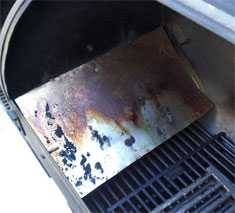
2) Make a flap of metal that covers the opening from the firebox to the cooking chamber at an bending and bolt it on. Information technology will deflect the heat and smoke downward. Or have a neighborhood body shop fabricate one for you. The picture here is a deflector made by Paul Salverda of Walnut, CA, from an aluminum cookie canvas and held in place by one cocky-tapping screw. He says the temperature unequal between sides before the deflector was forty-l°F and at present it is only about 10°F.
3) Cori Alcorn writes with this idea "I really desire ane of those convection plates but can't afford [a commercial] one and my wife wouldn't let me use one of her cookie sheets (she caught me with i of the former black ones that I idea would be fine and says information technology is her dandy grandmother's…). And so instead I wrapped the cooking rack closer to the firebox with foil and then poked slits in the foil and information technology seems to work pretty well. My temperatures evened out quite a bit. Just thought I'd mention my solution for the po' human being's convection plate."
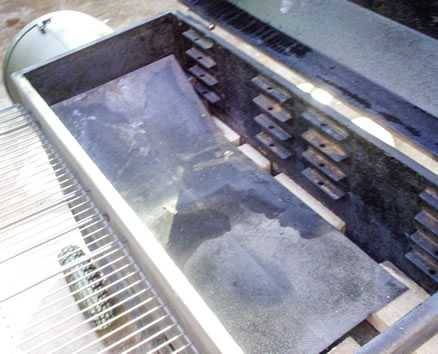
4) Another pick is to have a local body shop fabricate a baffle for you. Coleman Shelton did that and set it on bricks at right. A plate like this will radiate heat and motility a lot of it over to the right side away from the firebox. Here is a supplier that sells prefab deflectors.
5) The ultimate solution is to fabricate a heavy steel duct like the ones built into the large commercial offset smokers and move the chimney to the side by the firebox. This blueprint is called reverse flow. This directs all the smoke to the far side of the cooking chamber within the duct, information technology travels up into the cooking chamber and across the food to exit the chimney. The duct also radiates heat up to the meat as shown in the analogy below.

Extend the chimney downward. Hither's the concept: These smokers accept a chimney mounted on the top. Oestrus and smoke travel from the firebox across to roof of the cooking chamber to the chimney and out. If you can lower the intake of the chimney to the level of the cooking surface you lot can move the rut and smoke beyond the grates at the same level equally the nutrient. One way to practise this is with some aluminum roof flashing from your hardware store. Coil it up, insert it into the chimney from beneath, allow it expand to the aforementioned bore as the chimney, and pull information technology down to grate peak. I bought a scroll of 0.0092″ thick aluminum flashing 14″ loftier and 10′ long. I cut off 8″ and fabricated my chimney extension from that. Flashing costs about $8 for a curlicue.
Another manner is to remove the chimney altogether, encompass over the hole, and put in a new chimney downward low as barbecue enthusiast Bruce Melt has done, to a higher place (photograph credit: Bruce Cook). Here's how he described the procedure: "I cut a hole just below grate level and welded an elbow to the side of the pit. And then I used an exhaust pipe off of a semi-tractor, I so stuck the exhaust piping into the elbow. Any metal tube that is 4-6″ in diameter would work." Clever fellow with the correct last name, no?
Add together a water pan to the firebox. I like putting humidity into the cooking chamber to help keep the meat from drying out. There is some prove that moisture and combustion gases combine to meliorate the flavor. Then afterward the cooking sleeping accommodation is upwardly to rut and stabilized, I put a disposable aluminum pan filled with water on the cooking grate in the firebox direct above the coal basket. Cost: Almost $1.
Increase the chapters. The capacity of my COS is nearly half dozen slabs of St. Louis cut slabs laid lengthwise. For our large July four party, I demand more capacity so I utilise baby backs, which are shorter, and 3 rib racks. This ups my capacity to 15 slabs. Toll about $75.
Add a bottom grate to the firebox. My Char-Broil Silver Smoker came with a grate for cooking meat inside the firebox directly over the coals. It mounts only beneath the door. I use that to sizzle in sauce when I am done cooking ribs. I am told some models come with a lower grate for the charcoal to sit down on, but mine didn't and I've never seen them on the Silver Smokers I've looked at in stores. The coals sit down right on the bottom of the firebox with no airflow below them. So I bought a 13″ x 17″ grate from spare parts at Home Depot, and hack sawed it down to 13″ x fifteen″ so information technology would hover a few inches above the bottom of the firebox to allow air beneath the coals. Works, ahem, grate. Toll: Virtually $10.

Make a charcoal handbasket. The technique is to build a charcoal basket that will hold a large pile of coals inside the firebox. With such a handbasket you can use the Minion Method of fire control. Invented by Jim Minion, this is a clever technique of maintaining constant temp for a long time by filling the basket part way with unlit coals and and so you pour hot coals on peak. The hot dress-down slowly ignite the coals beneath them and the temperature remains remarkably steady for long periods of time.
Hither'south how to make a charcoal basket: (a) Go to your local torso shop and ask them to fabricate a square box about 12″ wide x 12″ long x 6″ deep from flattened expanded carbon steel sheets with a 3/4 inch diamond (or whatsoever they had on hand). Make sure these dimensions will fit in your firebox starting time. They tin can cut a four′ x 6″ length from a 4′ ten 8′ canvas, fold information technology to 12″ x 12″ x 6″, and spot weld the edges together. At that place is no need for a bottom if you have added a lower grate to the firebox every bit described above. (b) Purchase the the expanded metal and bend information technology yourself. So sew the corners together with wire or wire coat hangars. That'south what Paul Salverda did in the moving picture higher up.
Make a mud pan charcoal fuse. "Mark from South Minneapolis" invented this clever device for creating a wearisome steady burn. Y'all tin can put it in the firebox, merely he prefers to put it on one side of the cooking sleeping room and no longer uses his firebox. The "fuse" (a.k.a. maze, C, or snake) concept is a clever thought. You pour lit coals on top on one end of the fuse and the coals ignite gradually, like a fuse, moving from i stop to the other putting out a steady heat along the mode. He says "Choice up two sheetrock mud pans from any home improvement store, nigh $10 each. [Use stainless steel simply, galvanized can offgas toxins]. They measure iv″ x xiv″ each, so 2 of them will occupy only viii″ of width yet the three″ to 4″ height will hold enough of coals and forest chunks with ease. Drill some holes in the bottoms, ends, and sides. Then cut matching notches out of each with tinsnips leaving the flap on 1 to create a bridge between the two trays. I didn't permanently connect mine and then I can place them individually or together at the aforementioned fourth dimension. Fill with charcoal, leaving a space at 1 end for lit dress-down. Two trays will piece of work on a twenty″ butt grill but if y'all have more space you can add a tertiary or quaternary tray to extend the burn down time. If you lot're doing a very long cook you can simply remove the tray of expired coals backside the fire, refill it while the other continues burning and place the refilled tray dorsum in position. Pretty versatile and easy to do. Why didn't I call up of this earlier? Like shooting fish in a barrel and cheap this set-up will produce a consistent 225°F temp with the proper fuel load for 4 to 5 hours."

Plug the leaks. Yous can't cook unless you tin control the temperature and you tin't command the temperature if you can't control oxygen to the fire. There are several products on the marketplace that tin help. Click here to see some of the sealants and gaskets available. Our page about spare parts has links to gaskets, sealants, deflector plates and more.
Thickness of the metal doesn't thing that much. Metal absorbs oestrus simply doesn't radiate information technology much. Heat loss from cooking chamber is pretty much the same if the metal is thick or thin once it is heated upwardly. Radiation is minimal from the metal either to the outside air or inside to the food. Recall of belongings your hand over a bandage iron pan. Not that hot. Concord your hand three" from the cooking chamber on your offset. Non that hot. The rut for cooking the food comes from airflow, not the metal. And airflow is and so great. Insulating the cooking chamber. It is like insulating your house merely leaving front and dorsum door open.
The merely advantage to thick metal is that it will aid a little in stabilizing temp. I can help dampen temperature spikes. A ameliorate stabilizer is to put bricks in the lesser and cover them with foil. The cooking sleeping accommodation will have more time to heat up, but information technology will hold estrus longer and distribute it more evenly.
Of course preventing temperature spikes is best done by burn down control. By cultivating a small hot burn down. You want a small hot fire (read my commodity on combustion). Insulating the firebox makes more than sense than insulating the cooking chamber.
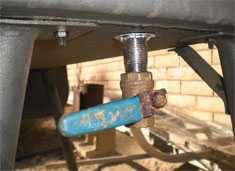
Make cleanup easier. Some COS come up with a small hole and a grease cup. Information technology overflows chop-chop and only works if the smoker is tilted towards the grease cup. One piece of cake solution is to line the bottom with foil. Some other clever solution, add a brawl valve every bit Paul Salverda did. Here's what he recommends: "Scrub the inside of the smoker with cleaner and a wadded up piece of foil. Put a bucket underneath the valve. Pour hot water into smoker, open valve. Repeat rinse. Wipe up the remainder. Admire your handiwork. Cook something!"

Add a chimney cap. A chimney cap like the i hither sits on superlative of the chimney, keeps the rain and snow out and prevents rust. The place I bought mine doesn't sell them anymore, only possibly you can observe a source.
Add together a thermostat.Our thermometer database has multiple thermostat controllers for charcoal and log burners. Many are bluetooth or wifi enabled so you tin lookout and manage your temps with smartphones, tablets, and computers.
You tin can fix information technology so alarms band when certain temps are reached or afterward an elapsed fourth dimension period. You can fifty-fifty claw it upward to a wireless router and command it from a web browser.

Get a good encompass. Go along pelting, snow, wasps, birds, and other vermin out. Cheapo covers final only a year or 2. A skilful embrace costs almost $threescore.
Steve Friend of Weatherford, TX, says "I have used a COS for several years with depression maintenance and no rust on the outside. It sits outside 365 days a yr. Everytime I employ it, after the cooking is done and while the cooker still warm, I become a inexpensive can of cooking spray (PAM) and spray the entire cooker from top to bottom. This kind of seasons the metallic much like a cast iron skillet. And then far then good, no rust and a shiny patina that makes it look new."
Our page about spare parts has links to gaskets, sealants, deflector plates and more.
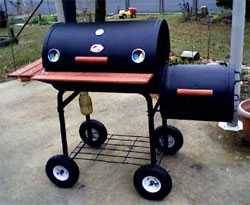
Char-Griller Mods

Bank check out the mods fabricated past Ted Hellewell, San Jose, CA. He has added a rotisserie, wheels, and a stainless steel work shelf. In addition to a gas burner, and deflector plate, he has added a bandage fe pan for wood chips above the burner. He says "The grate that the pan sits on needs to be as loftier above the burner as possible to tedious the wood burning process and extend fume times per load of woods. "I have made these same mods on 3 units for friends and family. My begetter too added them to his."
Rehab an an oldie goldie
Coleman Shelton of Calvert Urban center writes "I was about to buy a new smoker, and afterwards doing a little research I had settled on the Brinkman Cimarron. After reading your article about setting up a horizontal smoker, I decided to try rehabilitating something the previous owner of my business firm left in the lawn (built with 1/eight & 3/16 steel – damn matter is heavy).
"Cleaned it upward, added new wheels, added a [Char Griller] burn down box to i end, added a smoke deflector using some bricks & sheet metal I had laying around. Fabricated a charcoal basket from a fry basket I found in the bargain bin at the hardware store for $5. Used Dap High Heat Mortar to seal between the firebox & smoker, and to seal cracks.
"Ran a test yesterday and got half dozen hours at 225°F on one basket of lump charcoal. Temp control was adequately piece of cake. Used two digital thermometers to monitor, and simply had eight-10 deg variance from terminate to cease, measured at the racks.
"Total investment: $100. I figure I saved at least $500."
Gas conversion
Jeffrey Hammac in Tampa, FL, has converted his Char-Broil Silver Smoker (COS) from charcoal to propane. Here'southward how:
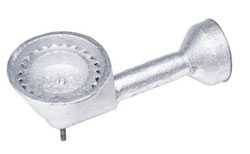
He bought a 20 psi regulator with hose for $25 and a high pressure cast iron burner for $11 at turkey fryers online.

You may be able to detect these parts at a hardware store or grill specialty store. Make sure you buy the proper psi regulator for the burner yous chose.

He drilled a pigsty on the inside of the fire bod large enough for the damper of the burner. He rested the neck of the burner on the inside of the hole.

There is a threaded stud at the bottom of the cast iron burner and then he drilled a vertical hole centered in the bottom of the burn box and used some washers to correct the height subsequently drilling the horizontal hole for the gas feed end. The burner does non come with a nut for the threaded stud so got ane at his hardware store.

He bought the the lava rocks at Wal-Mart for $4. To go on the tank steady, he has strapped it down with a bungee cord.
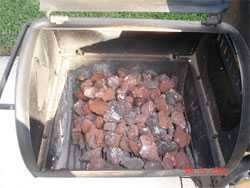
He warns that if you put wood chips in a foil packet over the flame it volition melt the packet so he puts it off to the side. I recommend you use a small cast fe pan for the wood chips, or put the correct on the lava rocks.
Practice. Practice. Practice.
Cook 1 slab at a time until yous have mastered the cooker and don't invite company over until then. You should get it nether command in 1 or 2 more tries.
Source: https://amazingribs.com/more-technique-and-science/grill-and-smoker-setup-and-firing/how-set-and-modify-offset-smokers-and/
Posted by: tripletttherhavery.blogspot.com

0 Response to "Data Light Turns Off On Char-broil Sikmple Smoker During Update?"
Post a Comment